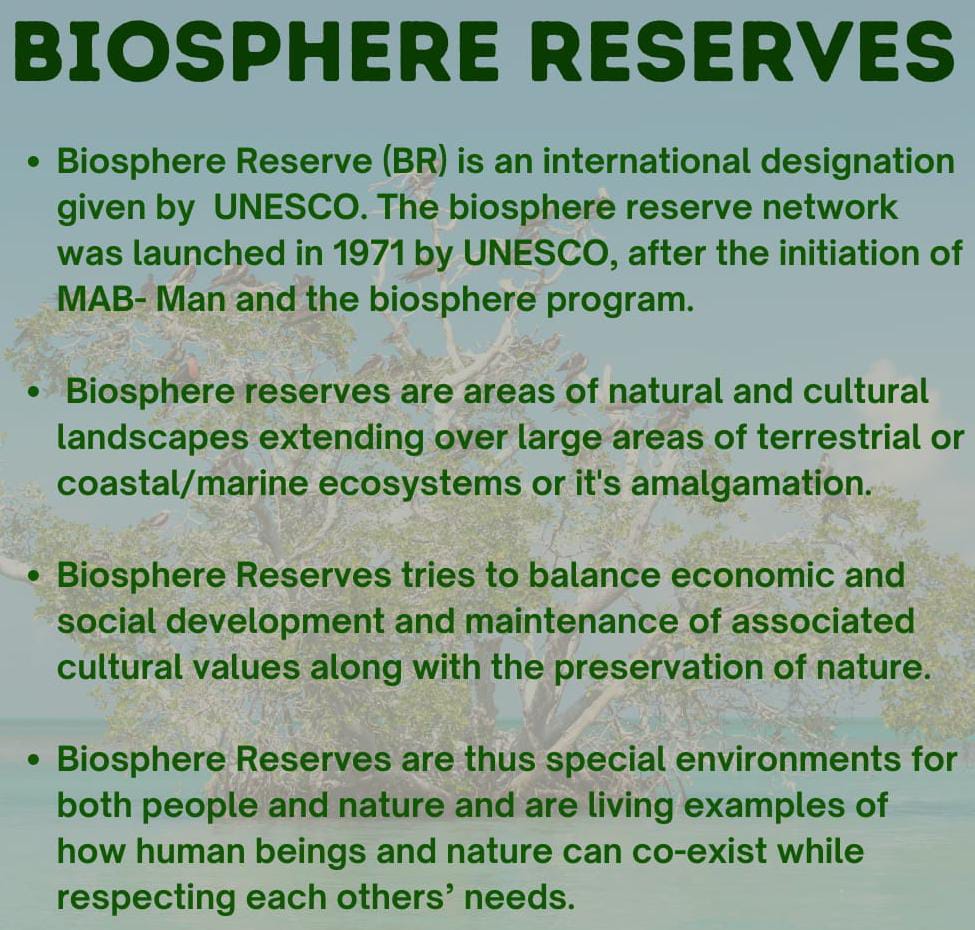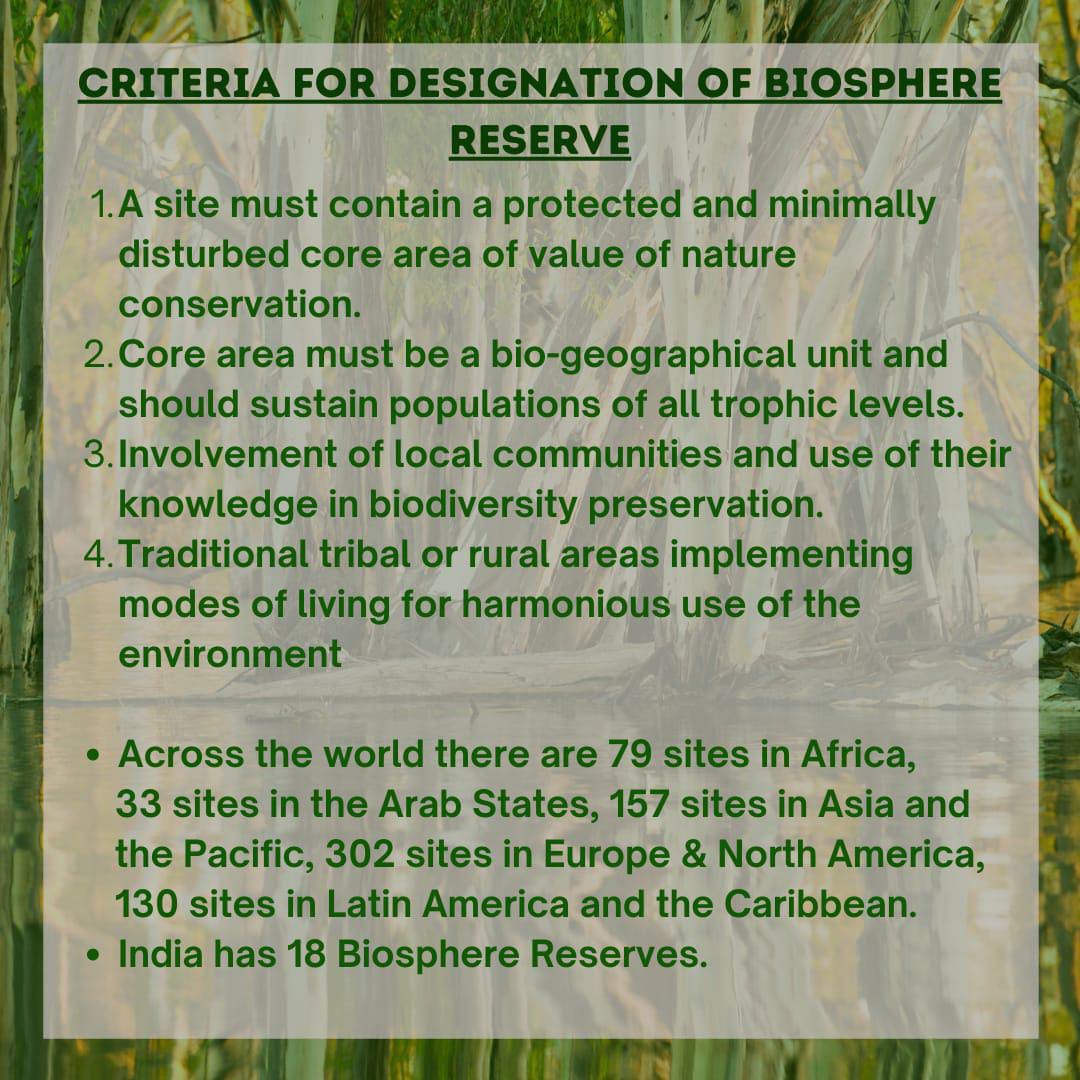Note4Students
From UPSC perspective, the following things are important :
Prelims level: Biosphere reserves, WNBR,
Mains level: Issues of concerns and efforts of conservation, India's efforts in biodiversity conservation
Context
- November 3 will be the first ‘The International Day for Biosphere Reserves’, to be celebrated beginning 2022. The World Network of Biosphere Reserves (WNBR) was formed in 1971, as a backbone for biodiversity conservation, ecosystem restoration, and living in harmony with nature.
What is biosphere reserve?
- Protected area: A biosphere reserve is an area of land or water that is protected by law in order to support the conservation of ecosystems, as well as the sustainability of mankind’s impact on the environment.
- Serves as a Platform to study: They are places that provide local solutions to global challenges. Biosphere reserves include terrestrial, marine and coastal ecosystems. Each site promotes solutions reconciling the conservation of biodiversity with its sustainable use.
- Learning places for sustainable development: Biosphere reserves are ‘learning places for sustainable development’. They are sites for testing interdisciplinary approaches to understanding and managing changes and interactions between social and ecological systems, including conflict prevention and management of biodiversity.
- Biodiversity conservation programs are carried out: To carry out the complementary activities of biodiversity conservation and sustainable use of natural resources, biosphere reserves are traditionally organized into 3 interrelated zones, known as: the core area, the buffer zone, and a transition zone or ‘area of cooperation.
- The core purpose: The purpose of the formation of the biosphere reserve is to conserve in situ all forms of life, along with its support system, in its totality, so that it could serve as a referral system for monitoring and evaluating changes in natural ecosystems. Each reserve aims to help scientists and the environmental community figure out how to protect the world’s plant and animal species while dealing with a growing population and its resource needs.
What is the process of recognition as Biosphere reserve?
- All biosphere reserves are internationally recognized sites on land, at the coast, or in the oceans.
- Governments alone decide which areas to nominate. Before approval by UNESCO, the sites are externally examined.
- If approved, they will be managed based on a plan, reinforced by credibility checks while remaining under the sovereignty of their national government.
Current status of Biosphere reserves
- Worldwide: There are 738 biosphere reserves in 134 countries, including 22 transboundary sites.
- In India:
- Presently, there are 18 notified biosphere reserves in India. Ten out of the eighteen biosphere reserves are a part of the World Network of Biosphere Reserves, based on the UNESCO Man and the Biosphere (MAB) Programme list.
- In India, the first biosphere reserve was designated by UNESCO in 2000, namely, the blue mountains of the Nilgiris stretching over Tamil Nadu, Karnataka and Kerala.
You must know- UNESCO Man and the Biosphere (MAB) Programme
- The MAB programme is an intergovernmental scientific programme.
- It aims to establish a scientific basis for enhancing the relationship between people and their environments.
- It combines the natural and social sciences with a view to improving human livelihoods and safeguarding natural and managed ecosystems.
- It promotes innovative approaches to economic development that are socially and culturally appropriate and environmentally sustainable.
What is World Network of Biosphere Reserves (WNBR)?
- Dynamic network of cooperation: The WNBR, an amazing network of sites of excellence, is a unique tool for cooperation through sharing knowledge, exchanging experiences, building capacity and promoting best practices.
- Fosters harmonious integration of people and nature: Its members are always ready to support each other. It fosters the harmonious integration of people and nature for sustainable development through participatory dialogue; knowledge sharing; poverty reduction and human well-being improvements; respect for cultural values and society’s ability to cope with change – thus contributing to the 2030 Agenda and the Sustainable Development Goals (SDGs)
- A tool to develop sustainable approach: The Network is one of the main international tools to develop and implement sustainable development approaches in a wide array of contexts
- The principle of Living with harmony: The best concept for ‘Living in Harmony with Nature’ that exists in the United Nations system, is the WNBR, making these places more important today than ever before, where humans are thriving and relearning how to live with nature.
Click and Get your FREE copy of Current Affairs Micro notes
Get an IAS/IPS ranker as your 1: 1 personal mentor for UPSC 2024



